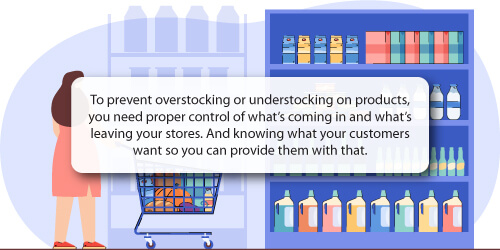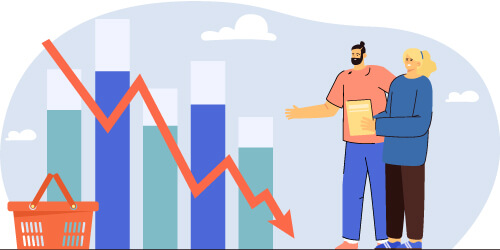There is a fine line between understocking and overstocking your store. On the one hand, you want to ensure you have enough stock to meet consumer demand*. However, you must be careful. Hold too much of the wrong product, and you sit with a problem - items that won't sell and take up too much space.

On the other hand, if you don't keep enough stock to meet demand, you'll have empty shelves and frustrated shoppers. Either situation is problematic. Fortunately, there are actions you can take to prevent both.

Understocked versus overstocked: What’s the difference?
Offering the right products at the right time, place, and price is crucial to compete in today's retail industry. Of course, that doesn't mean mistakes won't happen; mistakes like understocking or overstocking your stores.
Let's begin by understanding understocking and the reasons for it.
Understocking is when your supply of a particular product fails to meet consumer demand.
If a customer walks into your store, asks for a product and finds that you've run out, they'll leave dissatisfied and frustrated. If it happens often enough, they might not return.
Of course, the reasons for understocking your stores are not always your fault.
- Unexpected changes in the market
There could be an unexpected change in the market that you're unaware of, or it catches you by surprise. Does anyone remember panic buying when COVID-19 stuck? In that case, it's all about your ability to adapt to change. A contingency plan always helps.
Then again, other reasons are down to retailer error.
- Poor to no planning; and
- You don't know your market well enough
In both instances, it's best to rethink the strategy for your different categories.
Meanwhile, overstocking is the exact opposite.
Overstocking is where your supply exceeds consumer demand, leading to a surplus of products you struggle to sell.
These products also take up space on your shelves and in your storeroom. Again, the reasons for overstocking are similar to those around understocking.
- Poor to no planning; and
- You don't know your market well enough
That said, there is another reason.
- Giving in to your suppliers
Let's say you're a Consumer Electronics and Appliances retailer who stocks photographic equipment.
The sales manager for a particular camera brand walks into your store one day and notices you only have two specific DSLR models in stock. You're not a Destination store for photography, so it makes sense that you don't order more. However, the sales manager wants to sell more and persuades you to obtain additional stock.
One month later, none of your new stock has sold.

Understocking versus overstocking: What are the consequences?
When it comes to the consequences of understocking or overstocking your stores, there is one that overshadows every other repercussion.
- Money
In short, it boils down to money. More importantly, it's the loss of potential sales and profit.

Let's look at the consequence of overstocking an item to illustrate our point further.
- Not enough shelf space
As we alluded to in another article on why your retail space management matters, it doesn't matter if the product you stock is popular. If you have too much of it, you're overinvested.
As a result, you won't have enough shelf space (both in-store and in your storeroom) for the stock that sells and makes you money.
- Capital tied up in inventory
A knock-on effect of less available shelf space is that you've got capital tied up in inventory that you can't use. Overstocking is thus more damaging than you might anticipate.
Let's say, for example, you stock coffee and biscuits. However, you have too much stock in your Biscuits department, which means there is every chance of part of that department holding dead stock and, more importantly, dead capital.
As a result, instead of one poor-performing category, which you could fix quickly, you have two poor-performers.
Understocking your store has the same effect. If a customer visits your store looking for a product only to hear that it's out of stock, they're frustrated. A direct result is the loss of that sale and potentially that customer and any other purchases they would have made during that initial visit.
It becomes a more significant problem when you add up that single loss over an extended period, and you find it multiplied five, 10 or 20 times per week or month.

How to prevent understocking or overstocking on products in your store
1. Understand what consumer demand looks like per product
Before you look at what products you should stock and which categories to focus on, you need to understand consumer demand.
So how do you do that? Simple. It's all about getting to know your customers.
- What can they afford?
- What products do they want?
- What do they expect when they shop in your store?
For example, if your customer demands high-end products, don't stock cheaply made brands or packaged in boxes with unreadable labels.
If you're already in business, you understand demand by looking at your sales trends. It's best practice to look at six months of sales to get an idea. If, on the other hand, you've opened your store recently, you can do research by watching your direct competitors or asking people on the ground.

Let's use the example of the Consumer Electronics and Appliances retailer again. And let's say you located your store in a high LSM environment and need to cater to that market.
You could easily argue that you should stock the best kitchen equipment, cameras and TVs. However, what about the buying habits of your customers? Does what you have in store match what sells best?
One pattern could be that while they might spend a fortune on a coffee machine, playing thousands of dollars for the best product, they don't want to spend the same amount on a camera.
While you could stock high-end camera equipment, your sales figures would inform you otherwise. Thus, instead of combating the problem of overstocking a product, you can prevent it altogether by looking at what your customers buy.
2. Understand consumer demand trends by category, segment and sub-segment
You can base trends on historical sales data, so there is a way to predict what will sell during specific times of the year. That makes it especially easy to plan your assortment for seasonal events.
By looking at sales trends by category, segment or sub-segment, you can estimate future demand and plan accordingly.
That said, from another point of view, a trend is a forecast and isn't always accurate. That's especially true when you consider new trends. In such cases, it's about trial and error. A best practice would be to test a product in a smaller environment before launching it in all your stores.
In short, consider the LSM value of a product so you can position it in the market before making a final decision.
Let's take the example of 4K TVs released to the market a few years ago. It was a new trend, and there wasn't as much information about it. If someone came in to buy the product, they might not know that they couldn't use it yet since the available options for content were limited to a few countries. That meant that many would soon return, requesting a refund.
Imagine your supplier had overbet on these TVs selling well. They'd be in trouble because the product was too early to market. Your store would have wasted money and overstocked an item your customers can't use.

Conclusion
Overstocking and understocking are two issues to guard against if you want to be successful as a retailer. That's because of the short- and long-term implications of either.
If you know the pitfalls and how to avoid them - let alone prevent them - you're in a position to experience success.
Are you interested in a category management solution that can help you avoid the issues of having too little or too much stock in-store? More importantly, a solution that can ensure you always stock the products your customers want?
*This article was updated on 24 November 2022.


